A Numerical Analysis of the Temporal and Spatial Temperature Development during the Ultrasonic Spot Welding of Fibre-Reinforced Thermoplastics
Abstract
:1. Introduction
2. Materials and Methods
2.1. Modelling of the Heat Sources
2.2. The Numerical Model
2.3. Experimental Setup
2.3.1. The Laminates
2.3.2. The Welding Apparatus
2.3.3. Procedure
3. Results and Discussion
3.1. Calculation of the Matrix Loss Modulus
3.2. Analysis of the Thermal Problem
4. Conclusions
- Frictional heating occurs mainly at the weld apex during the weld initiation phase.
- The focused and rapid temperature increase due to frictional heating softens the weld interface.
- The strain energy consequently focuses at the softer interfacial layers.
- This leads to a uniform focused heating in the weld interface.
- As soon as the complete interface initiates to melt, the majority of the strain energy concentrates at a very thin polymeric matrix layer.
- This leads to a further intensive focused viscoelastic heating, causing the second temperature jumps.
- The viscoelastic heating increases the temperature up to the decomposition temperature of the matrix.
Author Contributions
Funding
Acknowledgments
Conflicts of Interest
References
- Osswald, T.A. Understanding Polymer Processing: Processes and Governing Equations, 2nd ed.; Hanser Publications: Munich, Germany, 2017. [Google Scholar]
- Villegas, I.F. Ultrasonic Welding of Thermoplastic Composites. Front. Mater. 2019, 6, 839. [Google Scholar] [CrossRef]
- Villegas, I.F.; Grande, B.V.; Bersee, H.; Benedictus, R. A comparative evaluation between flat and traditional energy directors for ultrasonic welding of CF/PPS thermoplastic composites. Compos. Interfaces 2015, 22, 1–13. [Google Scholar]
- Tutunjian, S.; Eroglu, O.; Dannemann, M.; Modler, N.; Fischer, F. (Eds.) Increasing the Joint Strength of Ultrasonic Spot Welded Fiber Reinforced Laminates by an Innovative Process Control Method. In Proceedings of the 18th European Conference on Composite Materials, Athens, Greece, 24–28 June 2018. [Google Scholar]
- Society, A.W. Single-Sided Ultrasonic Welding of CF/Nylon 6 Composite without Energy Directors. Weld. J. 2018, 97, 17–25. [Google Scholar] [CrossRef]
- Tutunjian, S.; Dannemann, M.; Fischer, F.; Eroğlu, O.; Modler, N. A Control Method for the Ultrasonic Spot Welding of Fiber-Reinforced Thermoplastic Laminates through the Weld-Power Time Derivative. J. Manuf. Mater. Process. 2018, 3, 1. [Google Scholar]
- Society, A.W. Online Inspection of Weld Quality in Ultrasonic Welding of Carbon Fiber/Polyamide 66 without Energy Directors. Weld. J. 2018, 97, 65–74. [Google Scholar] [CrossRef]
- Tutunjian, S.; Eroglu, O.; Dannemann, M.; Modler, N.; Fischer, F. A numerical analysis of an energy directing method through friction heating during the ultrasonic welding of thermoplastic composites. J. Thermoplast. Compos. Mater. 2019. [Google Scholar] [CrossRef]
- Kosloh, J.; Sackmann, J.; Šakalys, R.; Liao, S.; Gerhardy, C.; Schomburg, W.K. Heat generation and distribution in the ultrasonic hot embossing process. Microsyst. Technol. 2016, 23, 1411–1421. [Google Scholar] [CrossRef]
- Tolunay, M.N.; Dawson, P.R.; Wang, K.K. Heating and bonding mechanisms in ultrasonic welding of thermoplastics. Polym. Eng. Sci. 1983, 23, 726–733. [Google Scholar] [CrossRef]
- Levy, A.; Le Corre, S.; Villegas, I.F. Modeling of the heating phenomena in ultrasonic welding of thermoplastic composites with flat energy directors. J. Mater. Process. Technol. 2014, 214, 1361–1371. [Google Scholar] [CrossRef]
- Levy, A.; Le Corre, S.; Poitou, A. Ultrasonic welding of thermoplastic composites: A numerical analysis at the mesoscopic scale relating processing parameters, flow of polymer and quality of adhesion. Int. J. Mater. Form. 2012, 7, 39–51. [Google Scholar] [CrossRef]
- Levy, A.; Le Corre, S.; Poitou, A.; Soccard, E. Ultrasonic welding of thermoplastic composites: Modeling of the process using time homogenization. Int. J. Multiscale Comput. Eng. 2011, 9, 53–72. [Google Scholar] [CrossRef]
- Boutin, C.; Wong, H. Study of thermosensitive heterogeneous media via space-time homogenisation. Eur. J. Mech.-A/Solids 1998, 17, 939–968. [Google Scholar] [CrossRef]
- Wang, X.; Yan, J.; Li, R.; Yang, S. FEM Investigation of the Temperature Field of Energy Director During Ultrasonic Welding of PEEK Composites. J. Thermoplast. Compos. Mater. 2006, 19, 593–607. [Google Scholar] [CrossRef]
- Cojocaru, D.; Karlsson, A.M. A simple numerical method of cycle jumps for cyclically loaded structures. Int. J. Fatigue 2006, 28, 1677–1689. [Google Scholar] [CrossRef] [Green Version]
- Jedrasiak, P.; Shercliff, H.R.; Chen, Y.C.; Wang, L.; Prangnell, P.; Robson, J. Modeling of the Thermal Field in Dissimilar Alloy Ultrasonic Welding. J. Mater. Eng. Perform. 2014, 24, 799–807. [Google Scholar] [CrossRef] [Green Version]
- McHugh, J.; Döring, J.; Stark, W.; Guey, J.L. (Eds.) Relationship between the Mechanical and Ultrasound Properties of Polymer Materials. In Proceedings of the 9th European Conference on NDT, Berlin, Germany, 25–29 September 2006. [Google Scholar]
- Zhang, Z.; Wang, X.; Luo, Y.; Zhang, Z.; Wang, L. Study on Heating Process of Ultrasonic Welding for Thermoplastics. J. Thermoplast. Compos. Mater. 2009, 23, 647–664. [Google Scholar] [CrossRef]
- Willis, R.L.; Wu, L.; Berthelot, Y.H. Determination of the complex Young and shear dynamic moduli of viscoelastic materials. J. Acoust. Soc. Am. 2001, 109, 611–621. [Google Scholar] [CrossRef]
- Sands, D. Pulsed Laser Heating and Melting. In Heat Transfer—Engineering Applications; Vikhrenko, V.S., Ed.; IntechOpen: London, UK, 2011. [Google Scholar]
- Benatar, A.; Gutowski, T.G. Ultrasonic welding of PEEK graphite APC-2 composites. Polym. Eng. Sci. 1989, 29, 1705–1721. [Google Scholar] [CrossRef]
- Palardy, G.; Shi, H.; Levy, A.; Le Corre, S.; Villegas, I.F. A study on amplitude transmission in ultrasonic welding of thermoplastic composites. Compos. Part A Appl. Sci. Manuf. 2018, 113, 339–349. [Google Scholar] [CrossRef] [Green Version]
- Roylance, D. “Engineering Viscoelasticity,” Cambridge, MA, USA. Available online: http://mmrl.ucsd.edu/Courses/SE251B/Z_Roylance.pdf (accessed on 13 April 2020).
- Barbero, E.J. Finite Element Analysis of Composite Materials Using Abaqus; CRC Press: Boca Raton, FL, USA, 2013. [Google Scholar]
- Mallick, P.K. Fiber-Reinforced Composites: Materials, Manufacturing, and Design, 3rd ed.; CRC Press: Boca Raton, FL, USA, 2008. [Google Scholar]
- Johnson, W.; Masters, J.; Raju, I.; Wang, J. Classical Laminate Theory Models for Woven Fabric Composites. J. Compos. Technol. Res. 1994, 16, 289. [Google Scholar] [CrossRef]
- Lakes, R.S. Viscoelastic Materials; Cambridge University Press: Cambridge, UK, 2009. [Google Scholar]
- Lates, M.T.; Velicu, R.G.; Papuc, R. Sliding friction study of the oscillating translational motion for steel on PA66 and PA46 type materials. In IOP Conference Series: Materials Science and Engineering; IOP Publishing: Bristol, UK, 2016; Volume 147, p. 012038. [Google Scholar] [CrossRef] [Green Version]
- Mark, J.E. Physical Properties of Polymers; Cambridge University Press: Cambridge, UK, 2004. [Google Scholar]
- Mens, J.; De Gee, A. Friction and wear behaviour of 18 polymers in contact with steel in environments of air and water. Wear 1991, 149, 255–268. [Google Scholar] [CrossRef] [Green Version]
- Perng, L.-H. Thermal decomposition characteristics of poly(ether imide) by TG/MS. J. Polym. Res. 2000, 7, 185–193. [Google Scholar] [CrossRef]
- Prevorsek, D.C.; Kwon, Y.D.; Sharma, R.K. Interpretive nonlinear viscoelasticity: Dynamic properties of nylon 6, nylon 66, and nylon 12 fibers. J. Appl. Polym. Sci. 1980, 25, 2063–2104. [Google Scholar] [CrossRef]
- Kukureka, S.; Hooke, C.; Rao, M.; Liao, P.; Chen, Y. The effect of fibre reinforcement on the friction and wear of polyamide 66 under dry rolling–sliding contact. Tribol. Int. 1999, 32, 107–116. [Google Scholar] [CrossRef]
- Cai, Z.; Mei, S.; Lu, Y.; He, Y.; Pi, P.; Cheng, J.; Qian, Y.; Wen, X. Thermal Properties and Crystallite Morphology of Nylon 66 Modified with a Novel Biphenyl Aromatic Liquid Crystalline Epoxy Resin. Int. J. Mol. Sci. 2013, 14, 20682–20691. [Google Scholar] [CrossRef]
- Lienhard, J.H., IV; Lienheld, V. A Heat Transfer Textbook, 3rd ed.; Phlogiston Press: Cambridge, MA, USA, 2008. [Google Scholar]
- Lewis, R.W.; Nithiarasu, P.; Seetharamu, K.N. Fundamentals of the Finite Element Method for Heat and Fluid Flow; Wiley: Chichester, UK; Hoboken, NJ, USA, 2004. [Google Scholar]
- Wolanov, Y. Amorphous and crystalline phase interaction during the Brill transition in nylon 66. Express Polym. Lett. 2009, 3, 452–457. [Google Scholar] [CrossRef]
- Willett, P.R. Viscoelastic properties of tire cords. J. Appl. Polym. Sci. 1975, 19, 2005–2014. [Google Scholar] [CrossRef]
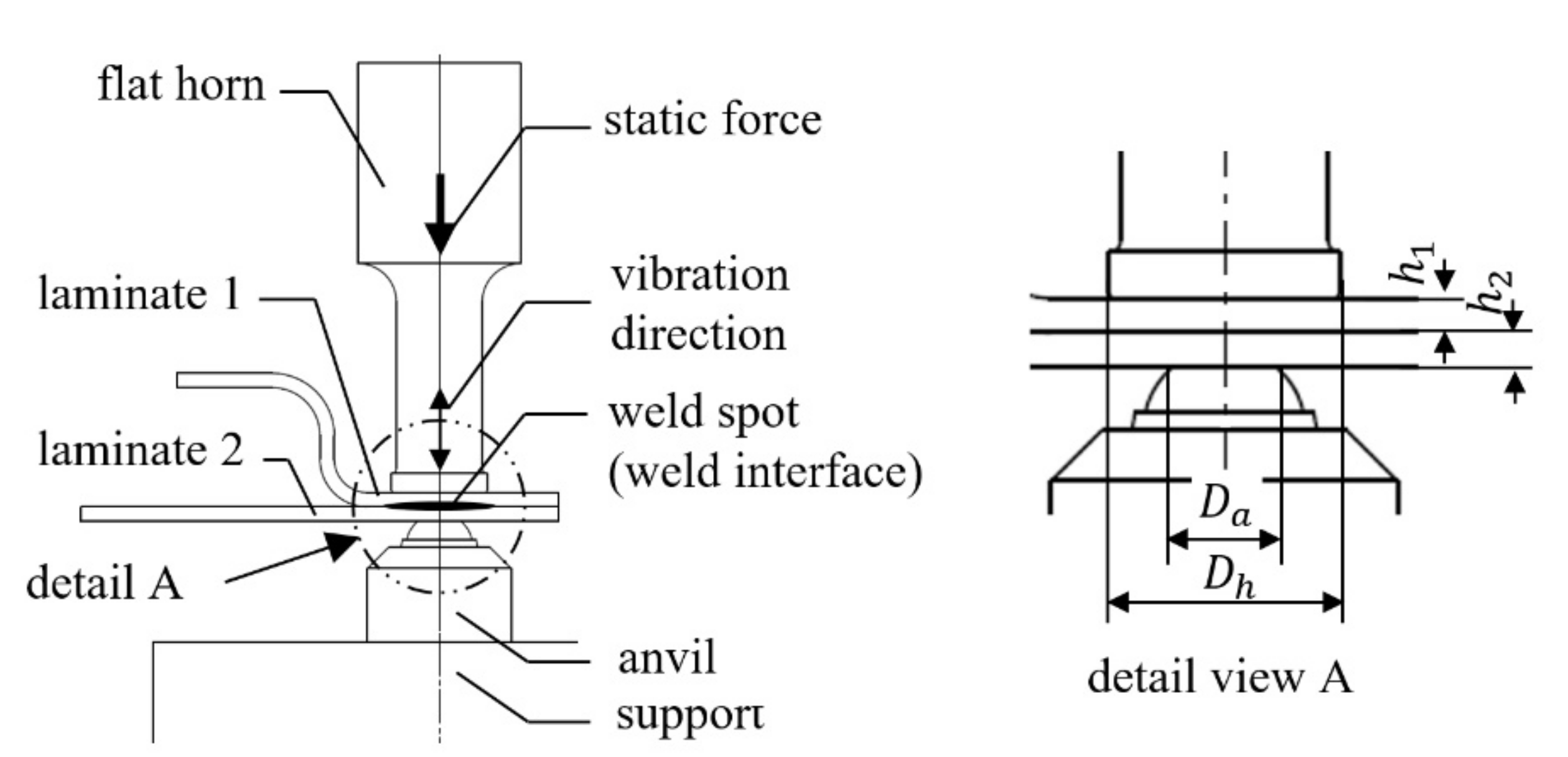
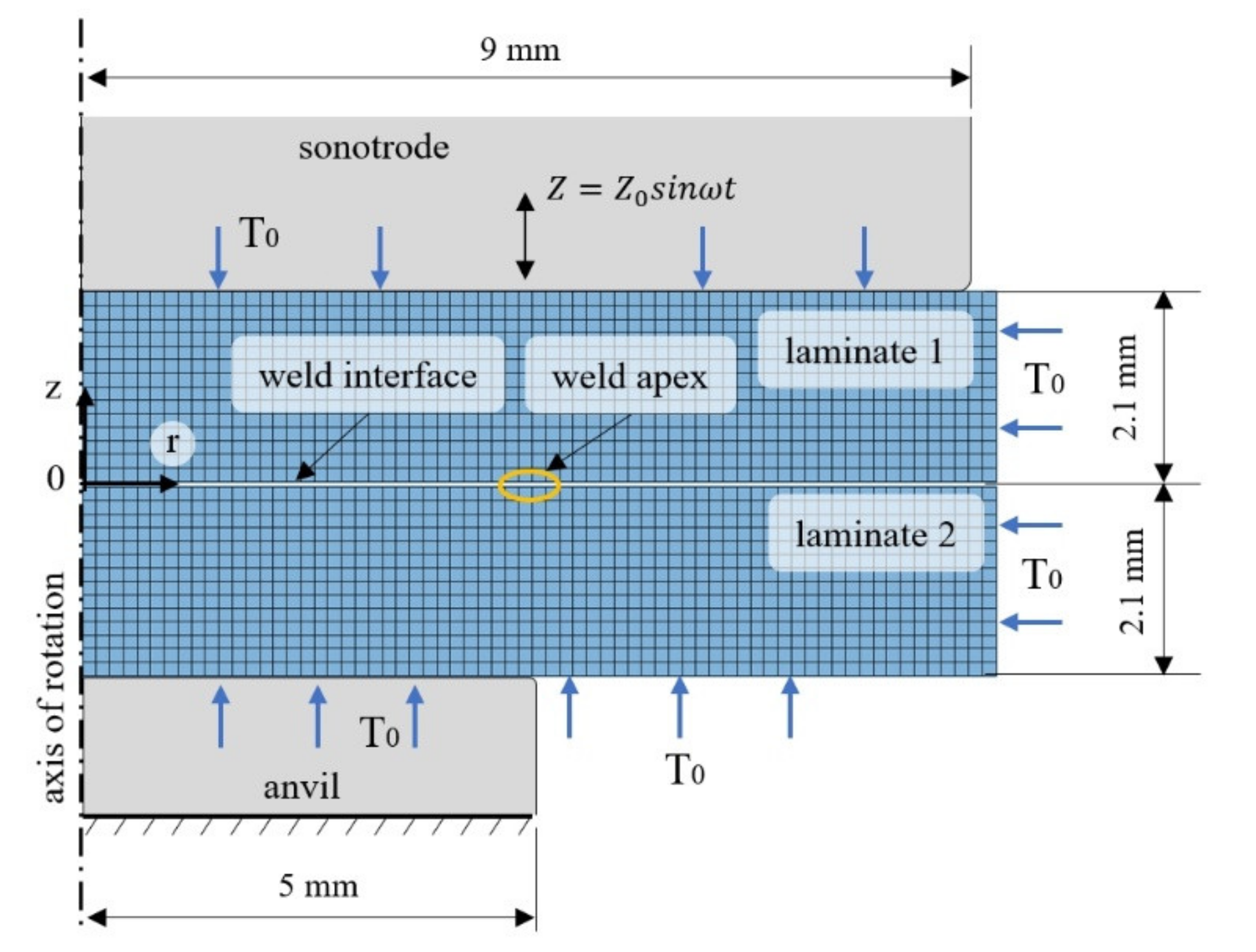


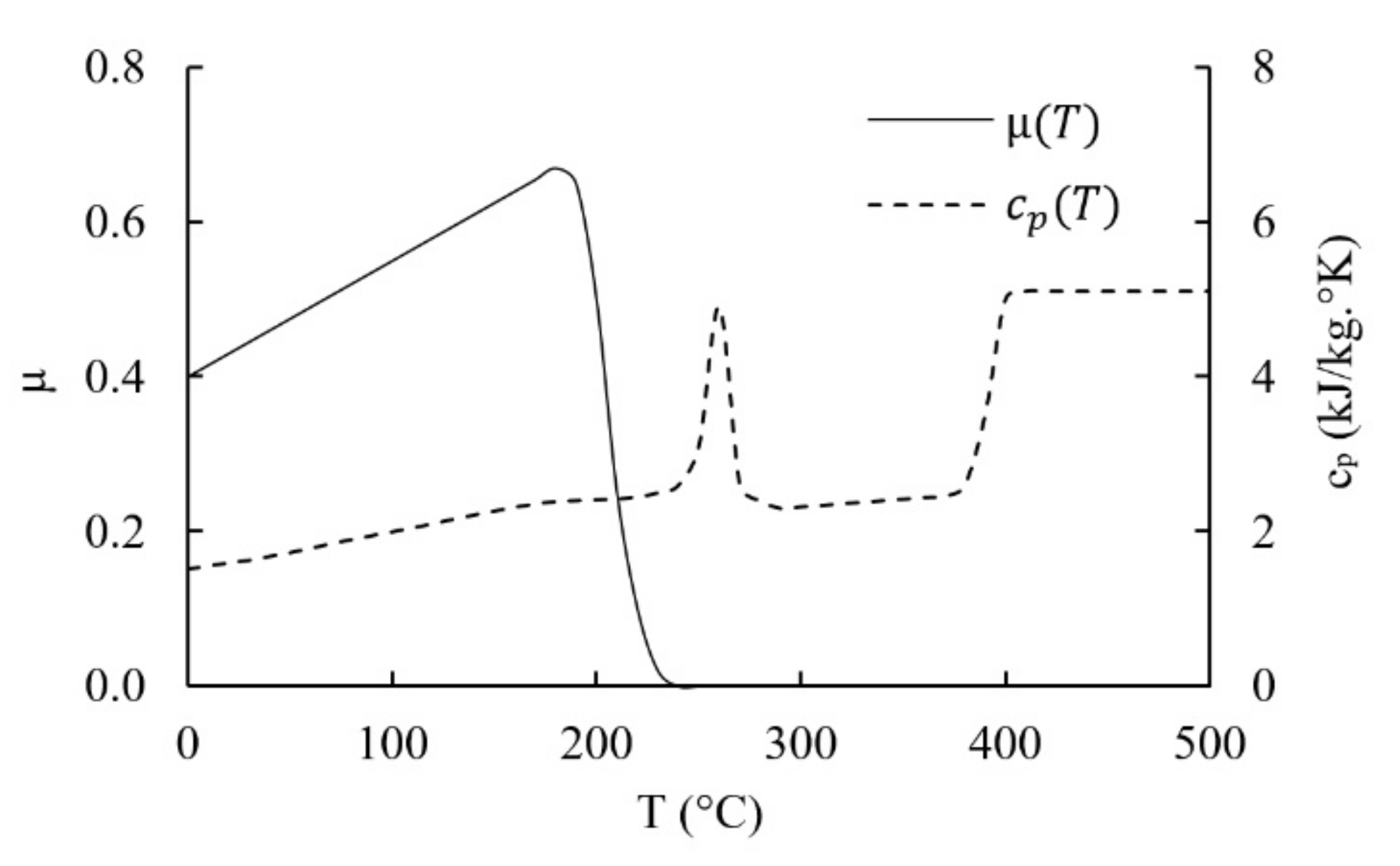


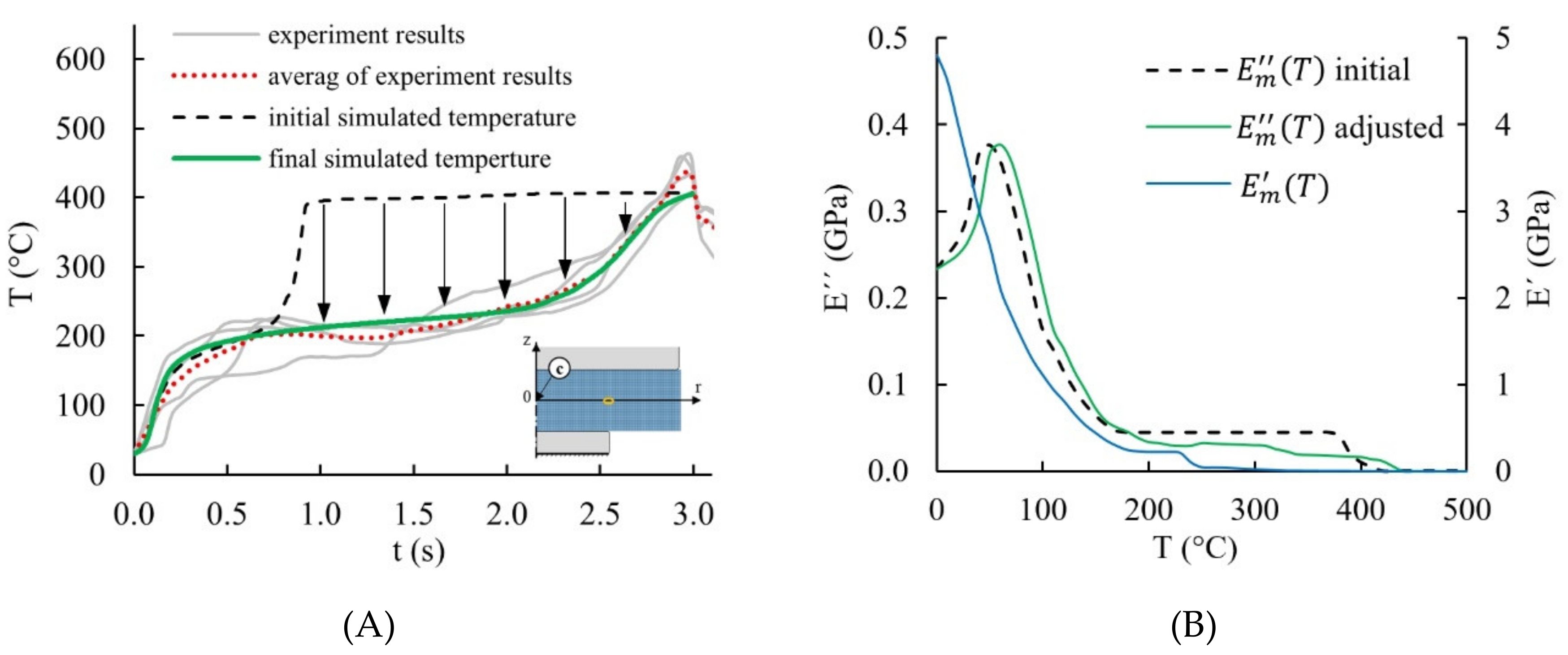

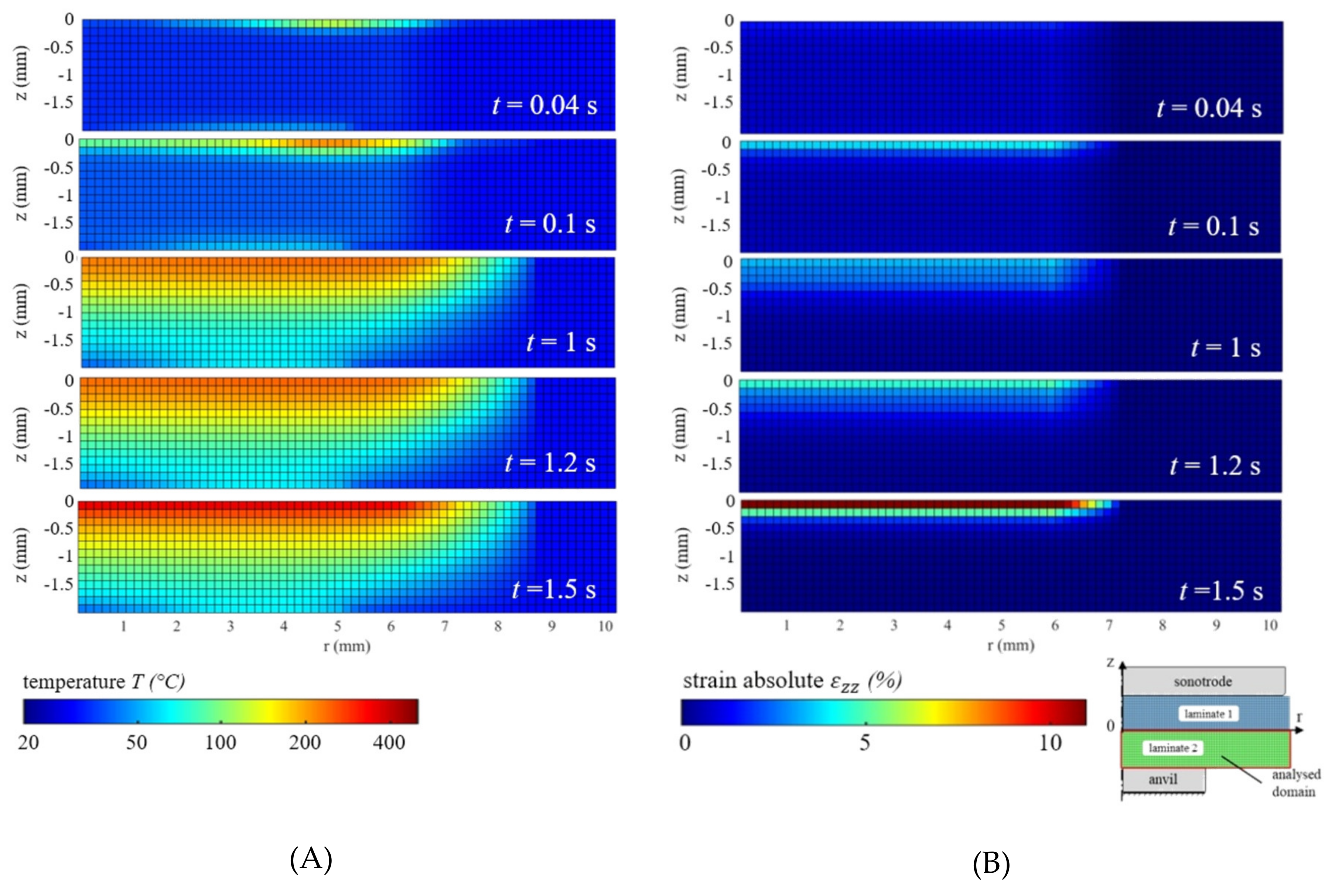
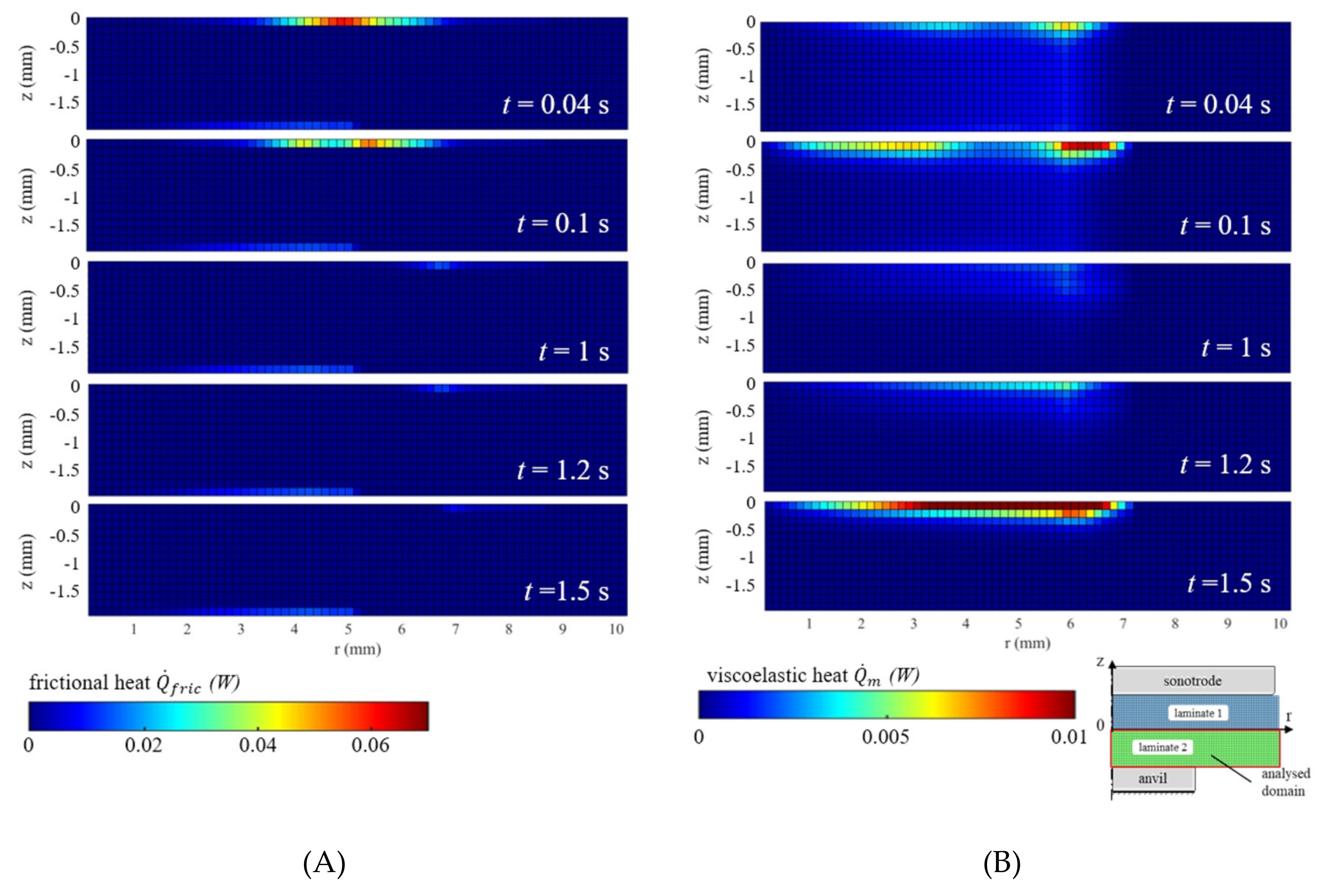
| Property | Value |
|---|---|
| (density of the composite) | 1515 kg/m3 |
| (in-plane elasticity modulus of the composite) | 55 GPa |
| (transverse elasticity modulus of the composite) | 11.5 GPa |
| Tg (glass transition temperature) | 53 °C |
| Tmi (melting point) | 240 °C |
| Tm (melting point) | 260 °C |
| Tdi (thermal decomposition initiation) | 358 °C [35] |
| Td (thermal decomposition temperature) | 400 °C [35] |
| k1, k2 (in-plane thermal conductivity) | 2.6 W/(m K) |
| k3 (transverse thermal conductivity) | 0.6 W/(m K) |
| (convective heat transfer coefficient) | 1.5 W/(m2 K) |
© 2020 by the authors. Licensee MDPI, Basel, Switzerland. This article is an open access article distributed under the terms and conditions of the Creative Commons Attribution (CC BY) license (http://creativecommons.org/licenses/by/4.0/).
Share and Cite
Tutunjian, S.; Dannemann, M.; Modler, N.; Kucher, M.; Fellermayer, A. A Numerical Analysis of the Temporal and Spatial Temperature Development during the Ultrasonic Spot Welding of Fibre-Reinforced Thermoplastics. J. Manuf. Mater. Process. 2020, 4, 30. https://doi.org/10.3390/jmmp4020030
Tutunjian S, Dannemann M, Modler N, Kucher M, Fellermayer A. A Numerical Analysis of the Temporal and Spatial Temperature Development during the Ultrasonic Spot Welding of Fibre-Reinforced Thermoplastics. Journal of Manufacturing and Materials Processing. 2020; 4(2):30. https://doi.org/10.3390/jmmp4020030
Chicago/Turabian StyleTutunjian, Shahan, Martin Dannemann, Niels Modler, Michael Kucher, and Albert Fellermayer. 2020. "A Numerical Analysis of the Temporal and Spatial Temperature Development during the Ultrasonic Spot Welding of Fibre-Reinforced Thermoplastics" Journal of Manufacturing and Materials Processing 4, no. 2: 30. https://doi.org/10.3390/jmmp4020030






